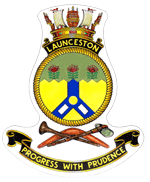|
HMAS Launceston (J179)
HMAS Launceston (J179/B246/A120), named for the city of Launceston, Tasmania, was one of 60 Bathurst-class corvettes constructed during World War II and one of 20 built for the Admiralty but manned by personnel of and commissioned into the Royal Australian Navy (RAN).[1] Design and constructionIn 1938, the Australian Commonwealth Naval Board (ACNB) identified the need for a general purpose 'local defence vessel' capable of both anti-submarine and mine-warfare duties, while easy to construct and operate.[2][3] The vessel was initially envisaged as having a displacement of approximately 500 tons, a speed of at least 10 knots (19 km/h; 12 mph), and a range of 2,000 nautical miles (3,700 km; 2,300 mi)[4] The opportunity to build a prototype in the place of a cancelled Bar-class boom defence vessel saw the proposed design increased to a 680-ton vessel, with a 15.5 knots (28.7 km/h; 17.8 mph) top speed, and a range of 2,850 nautical miles (5,280 km; 3,280 mi), armed with a 4-inch gun, equipped with asdic, and able to fitted with either depth charges or minesweeping equipment depending on the planned operations: although closer in size to a sloop than a local defence vessel, the resulting increased capabilities were accepted due to advantages over British-designed mine warfare and anti-submarine vessels.[2][5] Construction of the prototype HMAS Kangaroo did not go ahead, but the plans were retained.[6] The need for locally built 'all-rounder' vessels at the start of World War II saw the "Australian Minesweepers" (designated as such to hide their anti-submarine capability, but popularly referred to as "corvettes") approved in September 1939, with 60 constructed during the course of the war: 36 ordered by the RAN, 20 (including Launceston) ordered by the British Admiralty but manned and commissioned as RAN vessels, and 4 for the Royal Indian Navy.[2][7][8][9][1] Launceston was laid down by Evans Deakin & Co at Brisbane, Queensland on 23 December 1940.[1] She was launched on 30 June 1941 by the wife of William Forgan Smith, then Premier of Queensland, and was commissioned into the RAN on 9 April 1942.[1] Operational historyRAN serviceAfter entering service, Launceston was initially assigned to convoy escort duties in Australian waters before sailing to Colombo in September 1942 to join the British Eastern Fleet.[1] The corvette as used to escort convoys across the Indian Ocean.[1] On 11 February 1944, Launceston, sister ship HMAS Ipswich and the Indian sloop HMIS Jumna destroyed Japanese submarine Ro-110.[1] Convoy duties continued until September 1944, when the corvette returned to Fremantle for refit.[1] After refit, Launceston operated from Fremantle as an anti-submarine patrol ship until February 1945, when she was sent to Manus Island to join the British Pacific Fleet.[1] As part of the Pacific Fleet, the corvette was involved in the Battle of Okinawa.[1] Following the end of World War II, Launceston was based in Hong Kong as a minesweeper and anty-piracy patrol ship, before returning to Australia in late 1945.[1] Official visits were made to cities in Tasmania, including the corvette's namesake city, before the corvette sailed to Sydney.[1] The corvette received four battle honours for her wartime service: "Pacific 1942–45", "Indian Ocean 1942–44", "East Indies 1944", and "Okinawa 1945".[10][11] Turkish serviceAfter the war's end, Launceston was marked for transfer to the Turkish Navy.[1] The corvette was placed in reserve in mid-April 1946, then was recommissioned into the Royal Navy on 21 May as HMS Launceston for the transfer.[1] The corvette, along with sister ships Pirie and Gawler sailed for Colombo, where they were commissioned into the Turkish Navy.[1] Launceston was initially named TCG Ayancik and she served as a minelayer and minesweeper. She was later withdrawn from military service in 1965.[1] Then, she is transferred to Turkish Seamanship College and renamed as Hamit Naci after the founder of that school.[1] Citations
ReferencesBooks
Journal and news articles
|
||||||||||||||||||||||||||||||||||||||||||||||||||||||

